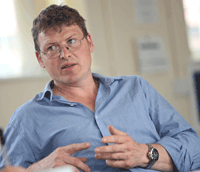FW Awards 2009: Pig Farmer of the Year finalist – Richard Hooper

If anyone can make a difference in the pig industry by portraying it to the public in a positive light, then Richard Hooper’s the man.
His passion and enthusiasm for the industry is infectious and with more than 2000 people passing through the 232-sow indoor unit at Harper Adams University College every year, he’s in a great position to influence visitors’ thoughts.
“It’s like getting a blank canvas and this means we can influence people. If we can educate in a fair and balanced way with the facts and dispel the myths and preconceptions, then the public may see the industry in a different light.”
But being pig manager at an agricultural college is challenging. With economic sustainability the main factor in the decline of many pig enterprises at colleges and universities, Richard has made every effort to ensure Harper Adams doesn’t fall victim.
When Richard took over the pig unit in 1998, he set about trying to pitch the unit as a research as well as commercial unit, which resulted in a total revamp in 1999, stocking it with 116 high health status sows. In 2007 the herd was then doubled to 232 sows.
Since redevelopment, the unit has consistently achieved above average performance, and has attracted more than £600,000 in research money in the past five years.
“My philosophy is to maximise meat output, but sometimes with trials there has to be compromise. Ring-fenced accounts mean I can decide where we go because it gives transparency.”
The college’s policy of retaining any surplus within the pig accounts has enabled continuous reinvestment and has also kept staff morale high, in turn improving herd performance.
This is definitely true because in the first six months of this year numbers born stood at 13.5, sow deaths remained below target at just four, weaned a sow a year stood at 26.21 and litters a sow a year stood at 2.22. Growth rates from weaner to slaughter are more than 650g a day, with an FCR of 2.26 and mortality less than 3%.
It’s the detail in the management that results in production figures like these, says Richard.
“Disease risk is minimised because replacements are bred on site and batch farrowing also enables an all-in, all-out policy. The fact sows are also fed in free access stalls – limiting competition at the feed face, helps keep numbers born up.”
With profit being made, Richard has recently been able to invest in new finishing accommodation. “With pigs being finished at three different sites, the new on site unit will be more labour efficient and will also generate more research,” he says.
“Although the new finisher unit will be slatted for research reasons, we still aim for it to be high welfare. There will be separate areas in each pen for loafing, lying and dunging and we are also thinking about including a system where saw dust could be delivered automatically to provide a rooting substrate, as well air scrubbing technology.”
Richard is confident intensive production will produce a low carbon footprint pig. “We are already looking to feed low nitrogen feeds and with the inclusion of an anaerobic digester at the college, even waste can be put to good use.”
When it comes to getting rid of waste the unit is already making some money, by selling the solid muck for £5/t to a neighbouring farm. An arable farmer then takes the slurry for crops.
But in a modest fashion, Richards says staff are the most important asset of the unit.
“You could have the best unit in the world, but if the people aren’t right it doesn’t work. They maintain and improve performance and build the reputation of the unit. I want people to see the job as a career and progress within it,” he says.
And building the reputation of the pig industry, not only with the public, but also with potential workers, is what Richard is also trying to achieve. “Having a commercially thriving and research active pig unit has and, hopefully, will continue to attract students in to a career in the pig sector,” he says.
What the judge’s likes
- “Although Richard has a different role to many other pig managers, he is using it to his advantage by promoting the pig industry to the public in a positive light. Richard is a different, but worthy candidate for this award.”
Three achievements
- Promoting pig industry in positive light
- Exceptional staff management
- Making money in a research environment
Farm facts
- 232-sow unit
- Research and commercial
- New welfare and environmentally friendly finisher unit
- Above average performance
- More on the Farmers Weekly Awards 2009
- Meet the finalists
